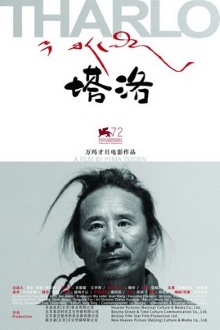
I do believe that this is the first bona fide Tibetan film I’ve ever watched. It was directed by Pema Tseden, a Tibetan with Chinese citizenship, is based on one of his novels and naturally uses their language. Wikipedia claims that this may indeed be the very first Tibetan black and white feature film but this seems unlikely to me.
Tharlo is a Tibetan goat herder who wears a distinctive ponytail in the traditional style. One day he visits the local police chief who he impresses by reciting from memory the entirety of a famous speech by Mao Zedong. At the same time he is instructed to get a proper identity card done and for that he has to go to town to have his photo taken. At the studio, the photographer asks him to get his hair cleaned up for the photo and so he meets the hairdresser Yangtso. While washing his hair, she queries him about his life and learns that while of the goats he takes care of belong to others, he owns enough to be fairly well off. He in turn is surprised to note that she flouts traditional norms as a Tibetan woman by smoking and wearing her hair short but seems attracted to her nonetheless. She invites him to a karaoke lounge together and they end up spending the night together. After he returns home, it becomes clear that he is enamoured and taken with the idea of finding someone to share his life with. This contributes to him being neglectful in his duties, leading to a number of goats being killed by wolves in the night.
The film is shot entirely in black and white with a completely still camera. This allows the director to wring the most out of every frame to make each one look almost as exquisite as a painting. Sadly the film never names the Tibetan city it is set in but I really appreciated this street-level view of life in it as it appears to be realistic and contemporary. The town scenes are reminiscent of Malaysia from maybe 30 years back while those set in the mountains give a good idea of what a goat herder’s daily routines are like. While the singing shown does sound a bit like chanting to our ears, I like that this is a film about ordinary Tibetans both in the city and in the countryside. All too often whenever we see Tibet on film, the focus is only ever on the monks.
Unfortunately I found the story to be a little too simple and predictable. What humor it has is based on Tharlo being a country bumpkin visiting the city for the first time. It’s amusing but feels dated and not really convincing. I also don’t like how he is depicted essentially as a 40-year old virgin with seemingly no experience whatsoever with women. I think that is just dumb reinforcement of lazy tropes. Under these circumstances, that his naivety gets taken advantage of isn’t much of a surprise and endlessly repeating the Tibetan song about finding a soulmate in life is way too obvious a telegraph. On this superficial level, I don’t think these themes are terribly interesting.
However another way of seeing this film is that it is lamenting the corrupting influence of Han Chinese on traditional Tibetan culture. Yangtso may be ethnically Tibetan but it’s clear here that she has been sinicized, preferring for example to sing Mandarin pop songs in the karaoke lounge, and dreams of visiting Hong Kong. Even the friendly police chief can be thought of being part of the intrusive Chinese bureaucracy intent on making sure that every Tibetan is accounted for as part of the system. It’s hard to read the final shot any way other than as a reference to the self-immolation protests by Tibetans. That the director has gotten into trouble with the Chinese authorities suggests that this is a valid interpretation. This does make the film better but I would say that it’s still lacking something. Tharlo’s encounter with Yangtso may have left him worse off than before but I’m not sure that he was truly happy before that. Similarly while Tibetan culture may wilt and change under the influence of Han culture, it’s not obvious to me from this film that this is necessarily a bad thing.
On balance my judgment is that this is a respectably solid work but by no means an outstanding one. The most valuable parts of it to me are that it bothers to depict ordinary life in modern Tibet at all while whatever themes it tries to overlay on top seem nebulous at best.